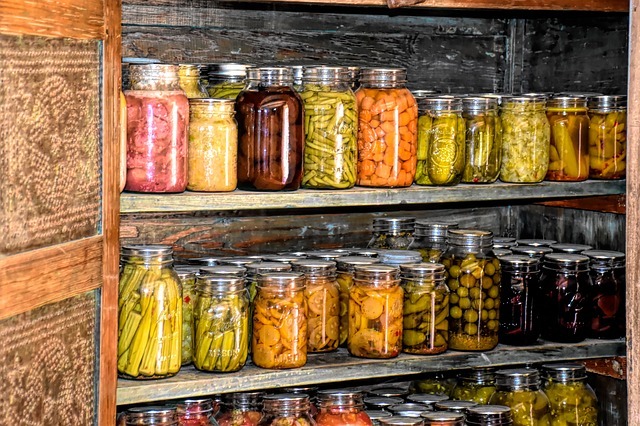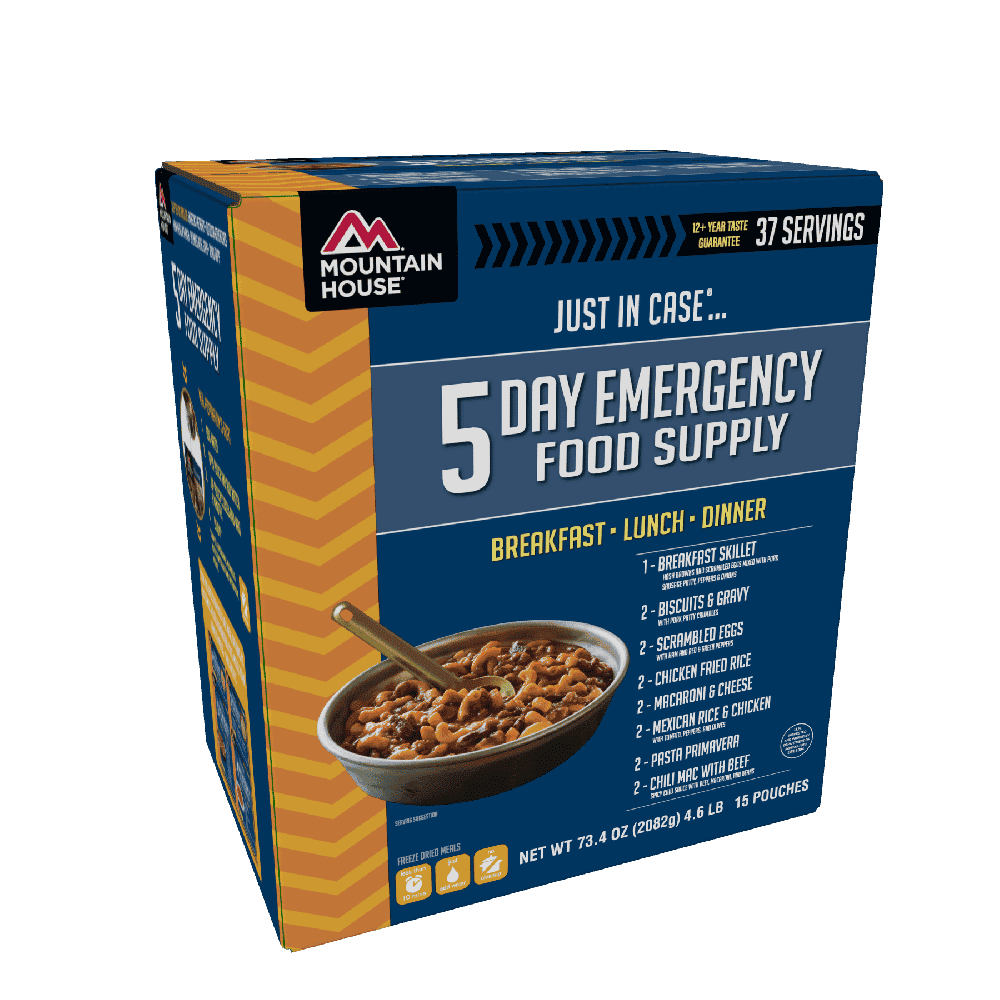Table of Contents
Before reading: Get a free food storage plan from prepping experts.
Introduction
Second to water, food is the most important resource when planning ahead for disasters or emergencies. Most folks have just a few days’ worth of food in their homes. Having a food storage plan is essential to any prepping plan.
How long could you feed your family with what is currently in your pantry/kitchen?
“Eighty percent of the people in the world have no food safety net. When disaster strikes – the economy gets blown, people lose a job, floods, war, conflict, bad governance, all of those things – there is nothing to fall back on.” -Josette Sheeran, former Executive Director of the UN World Food Program
Many people underestimate the importance of food storage planning, believing they will be able to purchase, grow, or hunt for the food they need in the occurrence of a crisis event. But each of those back-up plans are unstable or dependent on a very fragile system.
Let’s consider our grocery stores for a moment. I believe that many folks realize grocery stores can be stripped clean in a couple of days, but at the same time too many take for granted that services will be restored quickly. In the United States, only a tiny fraction of the food needed for our population is grown here. Food is mainly supplied by the trucking industry, which can easily come to a screeching halt if a variety of disasters should occur.
Growing your own food is time intensive, requires ongoing physical labor, and requires many variables working properly together in order to succeed.
Hunting is a valuable food storage planning option during a typical circumstance, but as we saw in the ammo shortage of early 2013, a single high profile tragedy, such as Sandy Hook, can quickly lead to bare store shelves and steep price increases. The decimation of the animal population is another scenario that must be considered.
These are just a few reasons why having an intelligent plan for adequate food storage before disaster strikes is non-negotiable. When I look at food storage as a whole, I see the necessity for three tiers of nutritional preparedness: short-term, long-term, and vitamin and oil storage.
Let’s look at each one in detail so that you can be well-supplied and well-prepared.
Week 1: Short Term Food Storage Planning
The Initial Stock Phase

The shortest of course is what is in the refrigerator.These perishables only have a few days at most before becoming unfit and dangerous to eat, and should be considered first. A freezer without power will also be useless within five to seven days.
Vacuum sealed and canned food will last several months so that can be mixed in with other long term foods. MREs (Meals Ready to Eat) are a great choice to store for short term use.They can be kept in various temperatures, although a stable temperature will yield the most nutritional product in the long term. Most food studies show storing such items between 60 to 70 degrees Fahrenheit as the ideal range.
My advice is to always store what you like to eat, and choose items with a long shelf life. Below is my short-term food storage list
Short Term Food Storage List
- Canned or dehydrated vegetables
- Canned or dehydrated meat, fish, and poultry.
- Canned or dehydrated fruit
- vitamin supplements
- canned or dehydrated dairy products such as eggs and milk
- comfort foods to serve as morale boosters
More on MRE’s
MRE’s were originally developed for the armed services. Currently, a MRE consists of:
- Entree
- Side dish
- crackers or bread
- spread
- Dessert
- Candy
- Beverages
- Hot Sauce or seasoning
- Flameless Ration Heater
- Accessories
MRE’s provide an average of 1,250 calories and 1/2 of the military recommended daily allowance of vitamins and minerals. I usually advise storing 7 days’ worth (21 meals) of meals per person to be stored as the minimum number of MREs to keep on hand. When chaos is at hand, these meals will provide all the nutrients you need with little preparation required.
Weeks 2-4: Long Term Food Storage Plan
For return to rule of law, but before trade and shipping commence
After consuming your short-term food supply for the first week, whatever catastrophe that has occurred will most likely begin to gain some order by the second week and individuals will be able to heat water. This means you will be able to prepare freeze dried and dehydrated foods, an excellent choice for long term food storage. They require only dry, cool conditions and will last for 15 years or more!
There are many US companies who supply foods in #10 cans and pouches. Pouches are great for portability, but being soft sided, they can be easily punctured. The #10 cans are larger but store neatly in boxes and can be stacked. See our selection of freeze-dried foods here.
DIYers can also dry and store their own food such as beans, grains, livestock food, and other foods with oxygen absorbers and food grade buckets. However, one must consider the amount of fuel needed to cook dried beans. Uncooked beans can cause harm to the digestive tract, and cooked beans require 8-12 hours of heating. Similarly, whole grain such as wheat berries must be run through a mill to be turned into flour. If this is the direction you want to go in, we recommend manual hand mills, as most disasters have power disruption.
The prepared meals mentioned before (most similar to camping meals – just add hot water) are higher in price, but in return offer convenience and speed. Do take the time to read the labels, as from a calorie standpoint, it is difficult to store enough calories for active, stressed people in only three meals. I recommend storing other foods, like freeze dried fruit, for snacks.
I usually recommend 21 days’ worth (63 meals, plus snacks) per person to be stored as a minimum number of prepared freeze dried/dehydrated meals.
I find it important to remind consumers that freeze dried foods should be properly reconstituted with water prior to consuming. Eating dried foods without proper water intake can cause water to pulled from the bloodstream and, in the worst case scenario, lean to intestinal obstruction. View my post on securing your off-grid emergency water source here.
The other component of long term storage is the freeze dried individual foods. This is for when some normalcy has been restored but there are still shortages of trucked supplied (food, medicine, clothes). This is when more involved recipes and actual cooking can start to take place. These foods can be put together to look like a familiar American plate – a meat plus two or three sides.
A word of waning, many ‘one year supply for one person’ offers are calorically restricted. In addition, they often contain large amount of staples, sugar, and flour, and absolutely no nutrition. Textured vegetable protein (TVP) is substituted for actual beef or chicken, and can be difficult to digest. I encourage folks to buy a few cans or pouches and try the product before investing in a larger supply.
Bonus: Vitamins and Oils
For Nutritional Boost
These are overlooked but vital additions to food storage. Vitamin deficiencies can occur within just a few weeks. Scurvy, the lack of vitamin C, is a serious deficiency characterized by poor appetite, exhaustion, ulcerated gums and loss of teeth. Because humans cannot synthesize vitamin C, it is usually added to our foods and present in fresh foods, resources that will be scarce in a disaster. Any multivitamin contains enough vitamin C to prevent scurvy.
Essential fatty acids (EFAs) are also vital, and deficiency in them becomes obvious within three to four weeks. Examples of these are EPA, ALA, and DHA, which are types of Omega 3 fatty acids. These fats are required for biological processes and are not just fuel.
Symptoms of EFA deficiency include fatigue, poor memory, dry skin, and heart problems.
Sources of EFAs are whole grains, fresh fruits/vegetables, fish, and olive oil. Canned sardines, salmon, and tuna, and olive oil should be considered as long term food storage staples.
Refer to the USDA chart of recommended daily amounts of vitamins and nutrients to determine the supply needed for use by your family. The chart will be highly useful when choosing the types of foods to place in both your long and short term storage supply.
Conclusion
Aside from water, food is one of the most important areas to have a strategy for in the case of an emergency. Waiting until the last minute will see you with empty shelves or sky-rocketed prices. Additionally, not every disaster is foreseen or predicted, so waiting until the last minute may not even be an option. Having a proper food storage plan will keep you, your family, and even your neighbors alive, healthy, and energized when other sources are no longer available.
Additional Tips for your Food Storage Plan:
I always recommend that you store foods that your family likes to eat. It is also important to include comfort foods in your food storage plan to provide a boost in morality and reduce the psychological shock that can occur when facing a disaster. This is especially important for children. The favorite at our house is Nutella ™, a chocolate hazelnut spread that usually has an expiration date of 18 months and can be used like peanut butter. We have also dry packed plain M&Ms ™ for 18 months with success. The candy shell seems to prohibit melting and the formation of the white coating that appears on regular chocolate after being stored. They also taste great!













